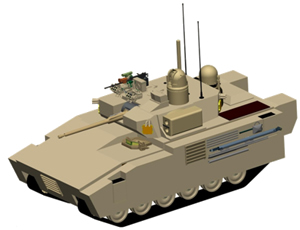

Three tag teams are in for yet another round of wrestling for future armored vehicle championship. As always, the teams are the same. As before, the championship prize is the Ground Combat Vehicle (GCV), with competing teams leaders are General Dynamics, BAE Systems and SAIC.
According to COL Andrew DiMarco, Project Manager, Ground Combat Vehicle, until the selection process is completed the Army is prohibited from disclosing any contractor bid, proposal information or source selection information. Contracts award is expected during the third quarter of Fiscal Year (FY) 2011.
All three finalist teams submitting proposals for the future vehicle have participated in the past development of the family of Manned Ground Vehicles, the armored vehicle foundation of the terminated Future Combat Systems program. All three teams have already participated in the previous phase of the GCV program which was cancelled last spring. Delivery of the first vehicle is scheduled seven years after TD contract award.
After evaluating the proposals submitted today, the Army is expected to award Technology Development (TD) contracts to two or all thee teams, awarding each team up to $450 for the 24 month technology development. The demonstrator will integrate all necessary subsystems and components to reduce technical risk and balances affordability while meeting system performance requirements. Each of the proposed technology solutions will have to pass Preliminary Design Review (PDR) after 18 months from the TD award. Although the development is capped at $450 million, financial incentives are offered to teams that would be able to save upon this costs. Teams will have six months past the PDR to further refine their systems before submitting them for the follow-on Engineering and Manufacturing Development (EMD), and final Production and Deployment phase (PD).
The goal of the TD phase is to reduce overall risk for entering into the EMD phase by developing an affordable, feasible and operationally effective preliminary design.
According to DODBuzz, in the final selection the service will choose a winner to build 1,874 IFVs. Those vehicles are currently projected to cost $9 million to $10.5 million apiece, not including the cost of spare parts and other support items. The Army also wants the vehicles to cost $200 per operating mile. This falls between the $100 per mile of the Bradley and the $300 per mile of the M1 Abrams tank.



















